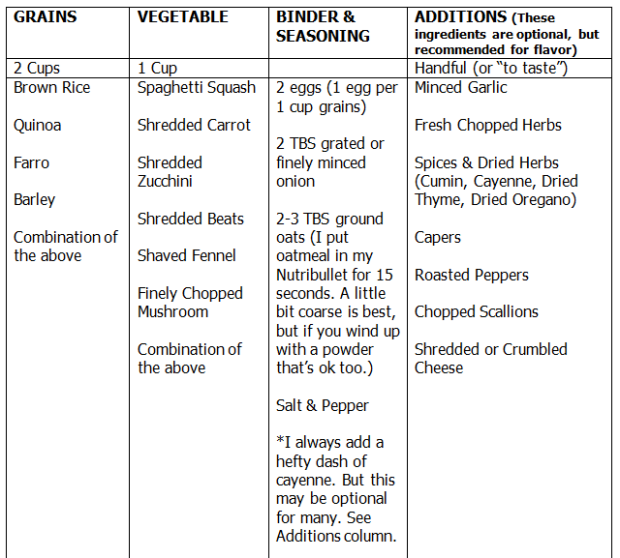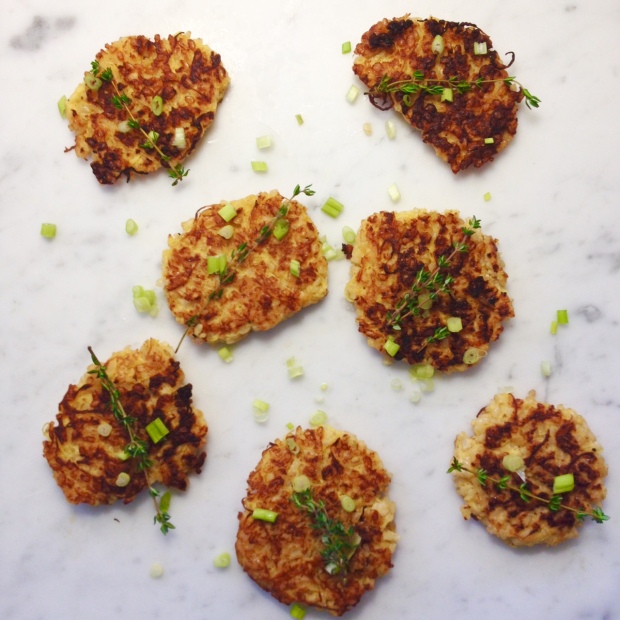
Organic brown rice, roasted spaghetti squash, minced onion, minced garlic, thyme, scallion, cayenne, salt and pepper. But the variations can be endless.
I’m a huge fan of finding ways to use up leftovers. It’s come to my attention that a lot of people loathe leftovers. I don’t understand this. Some of my best meals are the result of getting creative with random things I have on hand (leftovers), and basic pantry items. Using up leftovers is a great way to learn creativity in the kitchen, and more importantly, to learn how to cook without depending on a recipe. Bonus: cooking without a recipe can also save TIME (no measuring and reading as you go). Lastly, there is a certain satisfaction you get when you use up leftovers instead of throwing them away. (This is a great recipe if you have leftover rice from Chinese take-out).
The “recipe” for this is more just knowing the basic ratio of the main ingredients, and building off of that. You start with a 2:1 ratio of rice to vegetable. So, 1 cup rice to 1/2 cup veg, or 2 cups rice to 1 cup veg. You get the idea. Then, you mix in your binding ingredients, which are 1 beaten egg per 1 cup of rice, and 1-2 tablespoons ground oatmeal per 1 cup rice. Minced onion, salt, and pepper are the minimum requirements for flavor. Beyond that, GET CREATIVE with additions using what you have on hand. By following a few basic guidelines for consistency of the “batter” (discussed below), you’re on your way to a perfect side dish. I love these with my eggs in the morning.
My brain works in a very visual way, so I love charts because they let me organize and categorize info, etc. in a visual manner. I created this chart to demonstrate the adaptability of this recipe to what ingredients you have on hand. I’d love to know if this format/style works for anyone else, or am I the only freak?
CRISPY RICE CAKES
Ingredients: (Makes about 12-14 cakes, 3″ diameter)
Choose your grain and start with 2 cups of that. (This chart shows the many variations, but the basic recipe is 2 cups grain to 1 cup vegetable.) Add 1 cup of your chosen vegetable, then add your binders and seasoning, and follow the notes below.
1. IMPORTANT NOTES ON CONSISTENCY: The final consistency should be a wet, but “stiff” batter. It should NOT be pourable like a traditional pancake batter, that’s too thin. You want to be able to drop a dollop into a frying pan, and it will still maintain a ball shape, for the most part. Like a cookie batter. You will then flatten it with a spatula in the pan. It’s important to be aware of the water content of your vegetables, as these can have a big impact on the consistency. For example, zucchini, roasted red peppers, and mushrooms all contain a lot of water. Therefore, you may want to start with 1 egg instead of 2, and you may need 3 tablespoons of the ground oats instead of two. Always start with less liquid, because you can always add more, but it is much more difficult to correct a batter that is too thin, especially if you don’t have any more rice or vegetables to add. The best way to correct a batter that is too thin is to add more of the core ingredients (grain and vegetable). Cheese, particularly parmesan, is also good to both bind and thicken up a thin batter. Keep in mind that quinoa is a very delicate grain (it’s actually a seed), so you will need less egg and a nice sturdy vegetable, like shredded carrot, to have a cake that won’t fall apart.
2. Mix your ingredients, following the ratios set forth in the chart above, and keeping in mind the consistency notes above.
3. Start with a “test” pancake to test the consistency, heat of the pan, and flavor. Drop the “batter” by heaping tablespoon into a hot non-stick frying pan and flatten gently with a spatula. Use 2-3 tablespoons of your favorite oil that can withstand a medium to high heat. I typically use olive oil. Avocado, coconut oil, canola, and butter will work too. You should have enough oil to pan fry, but not “deep fry”. It should be hot enough that the cake will turn crispy and golden brown in about 3-4 minutes, and not burn or scorch. I typically flip mine twice. Doing a single test pancake first will let you check the consistency, heat of the pan, and most importantly, the flavor. You can adjust as needed and go from there to make the rest.
4. When the cakes are crispy and golden brown, take them out and put them on a plate to cool. They should not be very greasy or need to be drained on a paper towel. If that’s the case, you might be using too much oil, or your heat may be too low and they are absorbing the oil faster than they are cooking.
This is a lot of info for a very simple recipe. I promise once you make them once and get a feel for the consistency you need, you will see just how fast and easy they come together. Kids love them. (For kids, try these with brown rice, finely chopped cooked broccoli, and cheddar.) I hope you’ll try them and let me know how they came out!

Recipe inspired by and adapted from Maria Speck’s Simply Ancient Grains.